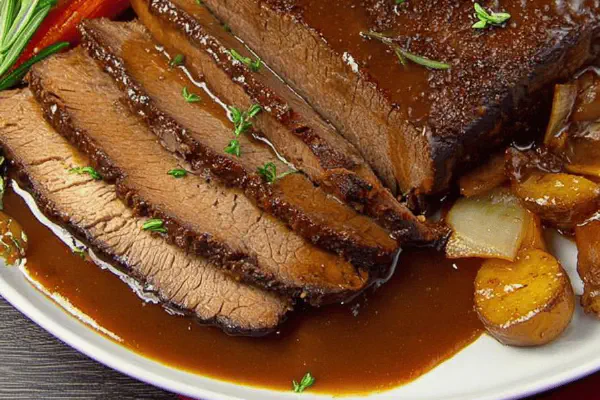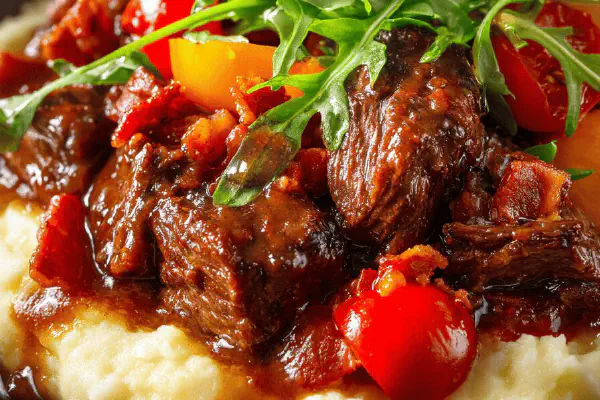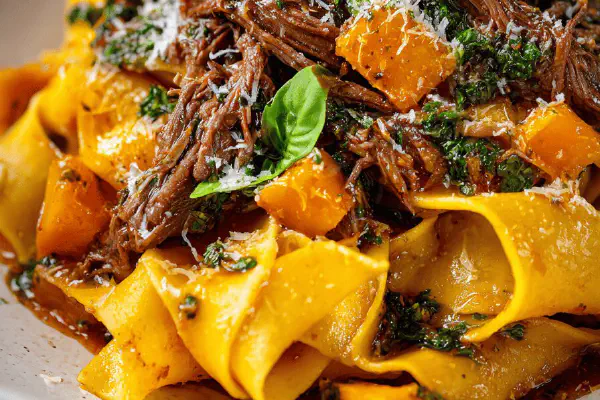Slow Braised Brisket

E
By Emma
Certified Culinary Professional
•
Recipe tested & approved
Brisket, dry salted and seared fat side down, builds deep color. Butter-flour roux browned in leftover fond thickens sauce later. Caramelized onions and garlic with tomato paste start flavor base, deglazed with red wine and beef stock. Meat gently poaches with herbs in oven, partially submerged, propped by onions to keep exposed fat crisp. After 3 hours, brisket removed. Liquid strained or not, reheated with roux for rich sauce. Careful watch for color not burn, fond not soggy. Replace flour with cornstarch slurry or arrowroot if gluten sensitive. Red wine can swap purple grape juice with vinegar. Timing based on sight and touch, not clock. Sauce smells shift from sharp raw to mellow sweet, thickening visibly. Sauce coats back of spoon, brisket yields to fork. Leftover braise imparts depth on next-day slices.
Prep:
15 min
Cook:
Total:
Servings:
8 servings
#beef
#braising
#American cuisine
#slow cooking
#comfort food
#gluten free option
#red wine
Brisket needs patience, not speed. Searing fat side down first, deep, dark caramelized crust forms. That crackle, that smell—that’s the bedrock of flavor. Then comes slow braise, gentle poach in aromatics and liquid, but keep top uncovered to keep that fat crisp. The roux, browned carefully, thickens jus into sauce, not glue. I’ve tried skipping roux and a mess resulted—watery sauce with none of that mouth-coating silk. Also, watch your onions and garlic—they can wreck sauce fast by burning. Low, slow, steady heat lets the meat relaxz, eat away connective tissue until fork-tender silk. Sauce thickens as it simmers, smelling sweet and deep, coating spoon. This isn’t fast food, it’s hospitality in a pot.
Ingredients
- 1 ½ to 2 lbs beef brisket
- Kosher salt and freshly ground black pepper for seasoning
- 3 tbsp unsalted butter divided
- 2 tbsp all-purpose flour
- 2 large onions quartered
- 4 cloves garlic thinly sliced
- 2 tbsp tomato paste
- 1 cup dry red wine
- 2 ½ cups beef stock
- Herb bundle: thyme, rosemary, parsley tied with kitchen twine
About the ingredients
Kosher salt essential for seasoning brisket heavily; regular salt fine but measure less. Black pepper fresh cracked for bite. Butter split in batches for roux and saute base. Flour can be replaced 1:1 with cornstarch mixed cold to slurry for gluten free version; add last to avoid clumps. Onions quartered keep texture, not mush. Garlic thin sliced releases aromatic oil without torching. Tomato paste should be good quality, concentrated for umami depth. Red wine dry type needed for deglazing; can swap for purple grape juice and 1 tsp apple cider vinegar if no alcohol. Beef stock preferably homemade or low sodium. Herb bundle tied tight with kitchen twine or cheesecloth stops leaves falling apart in liquid.
Method
- Oven set to 295°F for steady, low braise. Dutch oven heating on medium stove. Needs hot, not smoking.
- Brisket patted dry. Salt and pepper slapped on thick—don’t be shy. Fat side down into hot pan. No moving. Brown deep gold 7 minutes. Starts crackling, fat melting out.
- Fish brisket out, turn stove off. Use dead time chopping onions quartered, garlic sliced fine. Tie herb springs tight. This bundle thins smoke, stiffens flavor.
- Pan cooled slightly. Butter tablespoon dropped in. Stir swirled till melted, shimmer on bottom.
- Flour added all at once. Stir constantly, paste forming, paste browning. Tan hue. If pan feels cold, flick heat to low. Patience here builds nuttiness. No lumps allowed.
- Roux scraped off into bowl, covered. Chilling slows carryover cooking, keeps roux golden, not burnt.
- Clean pan with paper towel. Butter doubled now, melted medium heat.
- Quartered onions added, skin side down, let brown lightly, 5 minutes. They soften, edges caramelized, smell turns sweet and dense.
- Throw in tomato paste and sliced garlic. Stir 1 minute till aromatic, no burning—adjust heat as needed.
- Pour wine in. Sizzle and bubble, scrapes brown bits loose. Then beef stock added. Heat cranked until vigorous boil.
- Brisket set back in, fat side up. Liquids cover a bit less than half; top half dry to crisp. Use onions to prop meat if it wants to sink.
- Covered, slipped into oven for 3 hours plus 10 minutes. Oven heat steady; no peeking causing heat loss.
- Take out. Lift brisket, onions, herbs. Discard solids. Meaty aroma thick, slightly sweet. Keep warm, tented.
- Braising liquid over medium heat. Roux taken from fridge, stirred in slow with whisk or spoon. No clumps. Liquid thickens, coats spoon in 2 minutes heating.
- Slice brisket thin against grain. Serve with runoff sauce, generous pour.
- If wine scarce replace with grape juice acidulated with splash vinegar. For gluten free, swap roux flour with cornstarch slurry added last. Can skip roux—thickens less but sauce still tasty.
- Watch fond browning carefully. Too dark means bitter. Roux color affects sauce tone directly. Onions should soften but not blacken; burnt garlic poisons sauce.
Cooking tips
Heat control crucial. Pan must be hot before brisket or searing fails. No nudging meat until deep browning—allows crust. Roux needs constant stirring, cooks until pale golden, not blonde or darker or bitter. Remove roux early if darkening too fast. Cleaning pan between roux and saute prevents bitter burnt bits. Caramelizing onions medium heat; if pan too hot garlic can burn, toss in late. Deglazing with wine lifts fond flavor, don’t boil off all alcohol or sauce will taste sharp. Oven set slightly less than 300°F for guaranteed low heat slow cooking; too hot toughens meat. Braise liquid level just below brisket midpoint; submerging fat side loses that crucial sear texture on finish. Use onions as prop—lazy but effective. Sauce thickens quickly when boiling with roux—watch closely. Taste and adjust seasoning at final stage. If sauce lumps, strain or blitz with whisk off heat to smooth out. Rest brisket before slicing so juices redistribute. Slice thin, or texture feels heavy. Serve with sauce ladled generously.
Chef's notes
- 💡 Fat side down searing essential. Wait till pan smoking light. No flipping early. Crackle sound, smell deep brown. Patience here builds crust. Fumbling kills. If stuck, don’t force. Color decides doneness of sear, not timer.
- 💡 Roux color matters, stir nonstop. Pale gold is baseline. Browning roux develops nuttiness, but watch heat closely. Flick heat low if pan cools. Burnt roux bitter, ruins sauce fast. Chill roux off heat to stop carryover cooking.
- 💡 Onions quartered keep structure, skin side down caramelizes edges slow. Smell turns sweet, thick. Garlic slices last minute; burns poison sauce. Stir one minute max after tomato paste, adjust stove. Wine deglaze lifts fond, keep boil vigorous but don’t kill alcohol fully.
- 💡 Braising liquid level below midpoint brisket. Submerging fat side means soggy crust lost. Use onions as props to keep fat exposed, crisp after braise. Oven heat steady at 295°F, no peeking. Timing by look, smell, feel not clock. Sauce thickens visible, coats spoon.
- 💡 Substitute cornstarch slurry for roux in gluten free. Add last to hot braise liquid, stir quick to avoid lumps. Purple grape juice plus acidic vinegar swap red wine. Rest brisket after cooking, slice thin against grain. Thin slices reveal tenderness best.
Common questions
Why sear fat side first?
Fat renders slowly, protects meat, crust forms better. Sizzle tells readiness. Fat side down sizzles loud, smell deepens. Skip or move early and crust weak.
Can I skip roux?
Yes, sauce less thick but okay. Cornstarch slurry add late works too. Roux adds nuttiness texture missing otherwise. Stir well always or get lumps or thin sauce.
Sauce too bitter?
Usually burnt roux or blackened garlic. Reduce heat next time. Clean pan between roux and sauté. Watch onions darken but not black. Better safe than dark brown or worse burnt.
Storage tips?
Fridge in airtight. Save sauce separately, reheat slow mixing in roux thickens again. Slices wrap tight, moisture escapes if loose. Freeze slices flat for easy defrost.



